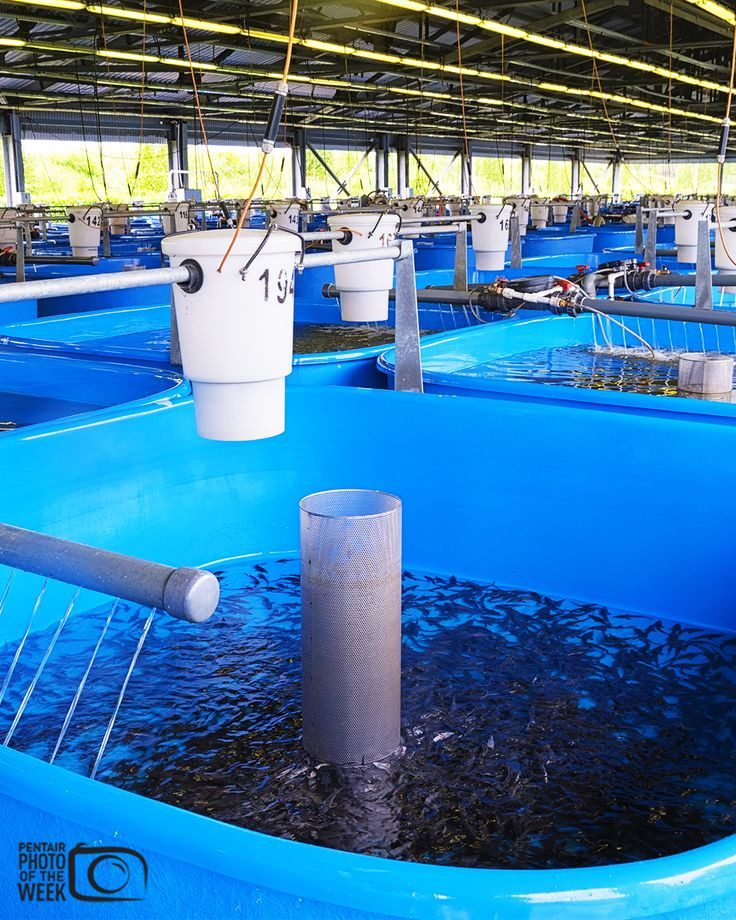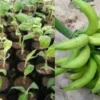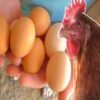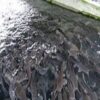Effective fish production and management are crucial for sustainable aquaculture practices. One of the essential aspects of a fish production and management guide is water management, leading to questions like how often should I change my catfish pond water?, what are the optimal water parameters for fish health and how can I implement a water recirculatory system in fish farming?
These questions are vital for any fish farmer looking to optimize their operation and ensure the well-being of their stock. Regular water changes are vital for preventing disease and maintaining a balanced ecosystem within the pond.
Proper water management not only supports fish growth but also reduces the risk of harmful algal blooms and other water quality issues. By understanding the answers to these questions, farmers can create an environment that promotes optimal growth and sustainability.
Additionally, implementing a water recirculatory system in fish farming can significantly enhance the efficiency of aquaculture operations. Such systems minimize water waste and create a controlled environment that supports healthy fish production.
This article will delve into best practices in fish production and management, focusing on maintaining water quality, efficient feeding strategies, and innovative systems designed to optimize your aquaculture efforts.
By understanding and applying these principles, fish farmers can achieve higher productivity and sustainability, ensuring a thriving operation that meets both economic and ecological goals.
Fish production serves as a vital source of protein, essential nutrients, and healthy fats for millions of people worldwide. With wild fish stocks declining due to overfishing and environmental degradation, aquaculture has emerged as a critical solution to supplement the global fish supply.
Fish farming supports food security and provides livelihoods for millions, particularly in developing countries. Understanding fish production involves delving into various methods and systems used to raise fish in controlled environments, including pond culture, cage culture, recirculating systems, and integrated multi-trophic aquaculture.
Each method has advantages and challenges, requiring tailored management practices to ensure optimal fish health and productivity.Pond culture is one of the most traditional and widely practiced methods.
It involves rearing fish in natural or artificial ponds, where water quality and fish health are closely monitored. Cage culture entails raising fish in enclosures submerged in natural water bodies, such as lakes or oceans.
This method allows for efficient use of water resources but requires careful management to prevent environmental impacts. Recirculating aquaculture systems (RAS) represent a more advanced approach, using technology to filter and recycle water within a closed system.
RAS minimizes water usage and allows for precise control over environmental conditions, making it suitable for high-density fish farming. Integrated multi-trophic aquaculture (IMTA) combines different species in a single system, leveraging their natural interactions to enhance productivity and sustainability.
Effective fish management is essential for the success of any aquaculture operation. It encompasses various practices aimed at ensuring optimal growth, health, and productivity of the fish stock.
These practices include water quality management, nutrition, disease control, and harvesting techniques. Water quality management is paramount, as fish are highly sensitive to changes in their environment.
Key parameters to monitor include temperature, pH, dissolved oxygen, ammonia, and nitrite levels. Regular testing and adjustments are necessary to maintain optimal conditions and prevent stress or disease outbreaks.
Proper nutrition is another cornerstone of fish management. Providing a balanced diet that meets the nutritional needs of the fish is crucial for their growth and health.
Fish feeds typically contain a mix of protein, fats, vitamins, and minerals. The formulation of these feeds varies depending on the species and their growth stage. Feeding practices, such as frequency and portion control, must be tailored to the specific requirements of the fish to avoid overfeeding or underfeeding.
Disease control is a critical aspect of fish management, as diseases can rapidly spread in aquaculture systems, leading to significant losses. Preventive measures include maintaining good water quality, proper nutrition, and biosecurity protocols to minimize the risk of disease introduction and spread.
In the event of an outbreak, prompt diagnosis and treatment are essential to mitigate impacts. Harvesting techniques also play a crucial role in fish management. Timing of harvest, handling methods, and post-harvest processing affect the quality and market value of the fish.
Proper planning and execution of these activities ensure that fish are harvested at the optimal size and condition, maximizing profitability.Sustainable fish production practices are increasingly important in modern aquaculture.
These practices aim to minimize environmental impacts, promote animal welfare, and ensure the long-term viability of fish farming operations. Key principles include responsible use of resources, waste management, and conservation of biodiversity.
Responsible resource use involves optimizing water and feed usage to reduce waste and environmental footprint. Implementing water recirculation and filtration systems, as well as using high-quality feeds with efficient nutrient profiles, are effective strategies.
Waste management is another critical aspect. Effluents from fish farms can impact surrounding ecosystems if not properly managed. Practices such as sedimentation ponds, constructed wetlands, and nutrient recovery systems can mitigate these impacts by treating and recycling waste products.
Conservation of biodiversity is also essential for sustainable fish production. Introducing non-native species or genetically modified organisms can disrupt local ecosystems and pose risks to native species. Adopting practices that preserve the genetic diversity of farmed fish and prevent their escape into the wild are vital measures.
Furthermore, sustainable fish farming often involves integrating aquaculture with other agricultural practices. Integrated aquaculture-agriculture systems, such as rice-fish farming or aquaponics, create synergies that enhance productivity and sustainability.
These systems leverage the natural interactions between plants and fish to recycle nutrients and improve resource efficiency. Economic considerations are integral to fish production and management.
Profitability depends on various factors, including production costs, market demand, and pricing strategies. Efficient management practices, such as optimizing feed conversion ratios and reducing mortality rates, contribute to cost-effective production.
Market demand and consumer preferences also influence the success of fish farming operations. Understanding market trends and adapting production to meet these demands can enhance profitability.
Value-added products, such as processed fish or specialty items, can also create additional revenue streams. Government regulations and policies play a significant role in shaping the aquaculture industry.
Compliance with legal requirements, such as licensing, environmental standards, and animal welfare regulations, is essential for sustainable and responsible fish farming.
Engaging with policymakers and industry stakeholders can help address challenges and promote best practices in the sector. Education and training are crucial for the development and success of fish production and management.
Knowledge of aquaculture principles, technology, and management practices enables farmers to make informed decisions and improve their operations. Training programs, workshops, and extension services provided by research institutions and government agencies play a vital role in building capacity and advancing the aquaculture sector.
Read Also: Five Economic Importance of Tilapia Fish
Importance of Water Quality in Fish Farming
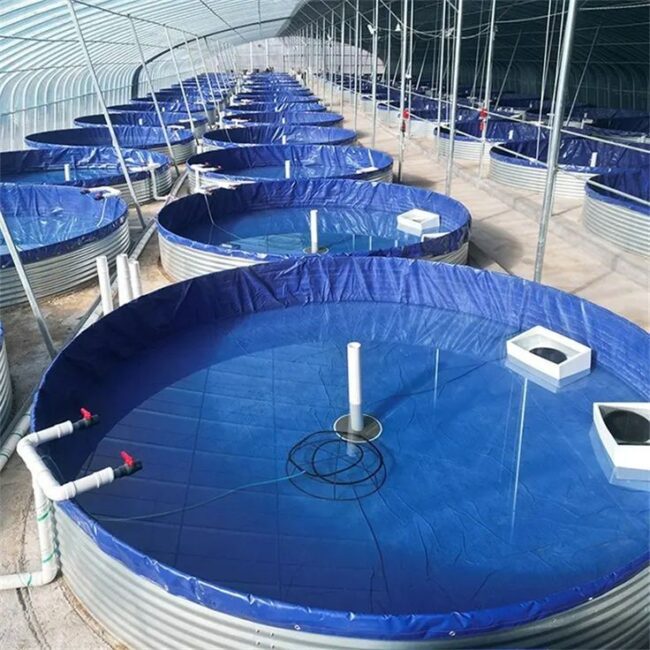
Water quality is the cornerstone of successful fish production and management. It directly impacts the health, growth, and survival of fish, making it a critical factor in aquaculture.
Maintaining optimal water quality involves managing several parameters such as temperature, pH, dissolved oxygen, ammonia, nitrites, and nitrates. Poor water quality can lead to stress, disease, and mortality among fish, ultimately affecting the productivity and profitability of a fish farming operation.
1. Temperature: Water temperature affects fish metabolism, growth rates, and immune responses. Different species of fish have specific temperature ranges within which they thrive. If the water temperature is too high or too low, it can lead to stress and reduced growth rates, and in extreme cases, it can be fatal.
2. pH Levels: Maintaining the correct pH level is crucial. The pH of the water affects the solubility and toxicity of chemicals and heavy metals. Most freshwater fish species prefer a pH range of 6.5 to 9.0.
If the pH falls outside this range, it can cause stress, reduce the efficiency of biological processes, and increase the toxicity of harmful substances. For instance, at a high pH, ammonia becomes more toxic, posing a significant risk to fish health.
3. Dissolved Oxygen (DO): Dissolved oxygen is one of the most critical water quality parameters for successful fish production and management. Fish require oxygen to survive, and the amount of dissolved oxygen in the water can vary due to factors such as temperature, salinity, and the presence of organic matter.
Low dissolved oxygen levels can lead to hypoxia, a condition where there is insufficient oxygen for fish to maintain normal physiological functions. Hypoxia can cause slow growth, increased susceptibility to disease, and even death. Therefore, ensuring adequate aeration and oxygenation of water is vital in fish farming.
4. Ammonia, Nitrites, and Nitrates: Ammonia, nitrites, and nitrates are products of fish waste and uneaten feed. Ammonia is particularly toxic to fish and can cause damage to gills and other tissues.
In a well-managed aquaculture system, beneficial bacteria convert ammonia to nitrites and then to nitrates through a process known as nitrification. While nitrates are less toxic than ammonia and nitrites, high concentrations can still be harmful over time.
Regular monitoring and management of these compounds are essential for successful fish production and management, helping to maintain a healthy environment for fish.
5. Water Hardness: Water hardness, which refers to the concentration of calcium and magnesium ions, influences the overall water chemistry and can affect fish health. Most fish species can adapt to a range of hardness levels, but extreme hardness or softness can cause stress and negatively impact growth and reproduction.
6. Alkalinity: Alkalinity, the water’s capacity to neutralize acids, is related to hardness and plays a role in maintaining stable pH levels. It acts as a buffer against pH fluctuations, which can be stressful for fish. Maintaining appropriate alkalinity levels helps ensure a stable and healthy environment.
7. Toxins and Pollutants: The presence of toxins and pollutants in the water is a significant concern in fish farming. Pesticides, heavy metals, and other contaminants can enter aquaculture systems from agricultural runoff, industrial discharges, or contaminated feed.
These substances can accumulate in fish tissues, leading to health problems and posing risks to human consumers. Regular testing for contaminants and implementing measures to prevent pollution are essential for sustainable fish farming.
8. Biosecurity Measures: Biosecurity measures are crucial in maintaining water quality. Preventing the introduction and spread of pathogens helps protect fish health and reduces the need for chemical treatments. Quarantine protocols, proper sanitation, and the use of disease-resistant fish strains are strategies to enhance biosecurity in aquaculture operations.
9. Water Exchange and Filtration Systems: Water exchange and filtration systems are vital components of managing water quality for successful fish production and management.
Regular water changes help dilute accumulated wastes and replenish essential nutrients. Mechanical and biological filtration systems remove particulates and harmful substances, maintaining clean and healthy water.
Recirculating aquaculture systems (RAS) are particularly effective in controlling water quality. They filter and recycle water within the system, minimizing water usage and allowing for precise control over environmental conditions. This technology is beneficial for high-density fish farming, where maintaining optimal water quality is challenging.
10. Feeding Practices: Proper management of feeding practices is integral to maintaining water quality. Overfeeding can lead to excess waste and uneaten feed, which decompose and degrade water quality. Implementing efficient feeding strategies, such as using high-quality, nutritionally balanced feeds and adjusting feeding rates based on fish size and consumption, helps minimize waste production.
11. Infrastructure Design and Maintenance: The design and management of fish farming infrastructure also play a role in water quality. Ponds, tanks, and cages should be designed to promote good water circulation and prevent stagnant areas where waste can accumulate. Regular cleaning and maintenance of these structures are necessary to prevent the buildup of organic matter and pathogens.
12. Biological Factors: In addition to physical and chemical parameters, biological factors also influence water quality. Algal blooms, caused by nutrient imbalances, can deplete oxygen levels and produce toxins harmful to fish. Managing nutrient inputs, such as controlling fertilizer runoff and optimizing feed formulations, helps prevent harmful algal blooms.
13. Regular Monitoring and Record-Keeping: Regular monitoring and record-keeping are essential components of water quality management. Implementing a systematic monitoring program allows farmers to track changes in water parameters, identify potential issues early, and take corrective actions promptly. Data collected from monitoring efforts can inform management decisions and improve overall farm performance.
14. Education and Training: Training and education for fish farmers are critical to effective water quality management. Understanding the principles of water chemistry, fish physiology, and environmental management enables farmers to implement best practices and respond to challenges effectively.
Extension services, workshops, and training programs provided by research institutions and government agencies play a vital role in building the capacity of fish farmers.
Read Also: Concrete Fish Pond Construction and Farming Guide
Understanding Water Recirculatory Systems in Fish Farming
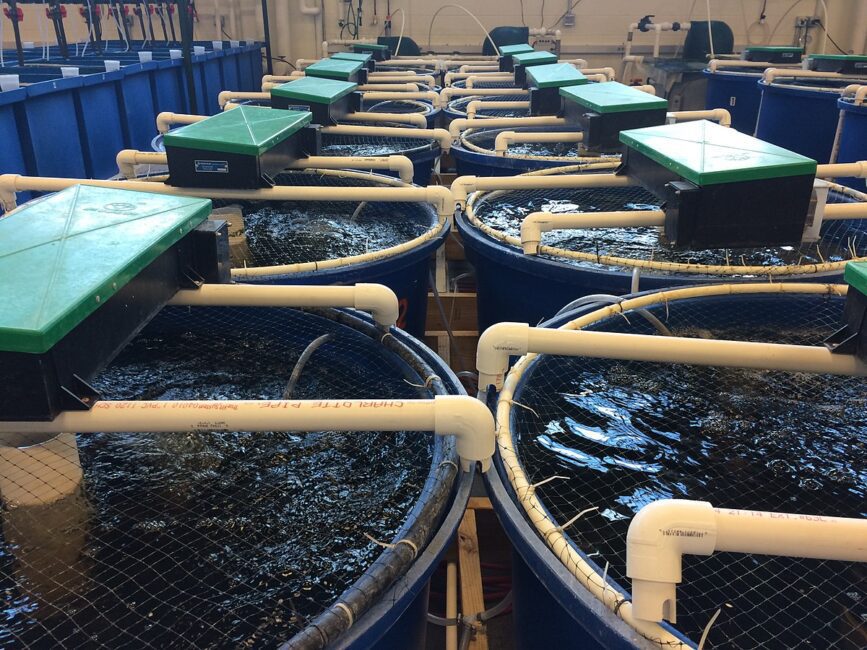
Water recirculatory systems (RAS) have revolutionized fish production and management by providing a sustainable and efficient method of cultivating fish. These systems recycle and treat water within a closed loop, significantly reducing water usage and allowing for precise control over environmental conditions.
1. The Importance of RAS in Fish Production and Management
In traditional aquaculture, water is continuously exchanged to maintain quality, leading to high water consumption and potential environmental impacts. RAS addresses these issues by minimizing water usage and treating waste products, making it a more sustainable option.
By recirculating water, RAS reduces the dependency on external water sources and minimizes the release of effluents into the environment. This not only conserves water resources but also prevents pollution and protects surrounding ecosystems.
Water recirculatory systems allow for precise control over key water quality parameters such as temperature, pH, dissolved oxygen, and waste concentrations. This level of control is crucial for optimizing fish health and growth.
By maintaining stable and optimal conditions, RAS enhances the efficiency of fish production and management, resulting in healthier fish and higher yields. Moreover, the ability to control environmental factors enables the cultivation of a wide range of species, including those with specific water quality requirements.
2. The Benefits of RAS in Fish Production and Management
1. Water Conservation: One of the most significant benefits of RAS is its water efficiency. Traditional fish farming methods can consume vast amounts of water, whereas RAS uses only a fraction of this by recycling and reconditioning water. This makes RAS particularly suitable for regions with limited water resources or where water conservation is a priority.
2. Waste Management: RAS includes sophisticated filtration and biofiltration systems that remove waste products, uneaten feed, and harmful chemicals from the water.
Mechanical filters capture solid waste, while biological filters use beneficial bacteria to convert toxic ammonia into less harmful nitrites and nitrates. This effective waste management system maintains water quality and reduces the risk of disease outbreaks.
3. Disease Control: The closed nature of RAS minimizes the risk of pathogen introduction from external water sources. Additionally, the continuous monitoring and treatment of water in RAS help prevent the buildup of harmful microorganisms. These factors contribute to a healthier fish population and reduce the need for antibiotics and other chemical treatments, aligning with best practices in fish production and management.
4. Space Efficiency: RAS allows for high-density fish farming, making it possible to produce large quantities of fish in relatively small spaces. This space efficiency is particularly advantageous in urban or peri-urban areas where land is scarce and expensive. By maximizing production per unit area, RAS supports the scalability and economic viability of fish farming operations.
5. Year-Round Production: The controlled environment of RAS facilitates year-round production regardless of external weather conditions. This consistent production capability helps stabilize supply, meet market demands, and ensure a continuous revenue stream for fish farmers. It also allows for better planning and management of production cycles.
3. Operational Aspects of RAS in Fish Production and Management
1. System Components: A typical RAS includes several key components: fish tanks, mechanical filters, biofilters, UV sterilizers or ozone generators, and oxygenation systems. Fish tanks house the stock, while mechanical filters remove solid waste.
Biofilters facilitate the nitrification process, converting toxic ammonia into nitrites and then nitrates. UV sterilizers or ozone generators disinfect the water, eliminating pathogens. Oxygenation systems ensure adequate dissolved oxygen levels for fish respiration.
2. Water Quality Monitoring: Continuous monitoring of water quality parameters is essential for the successful operation of RAS. Automated sensors and control systems are often used to track temperature, pH, dissolved oxygen, ammonia, nitrites, and nitrates. Real-time data allows for immediate adjustments to maintain optimal conditions, enhancing fish health and growth.
3. Maintenance and Management: Regular maintenance is crucial to the longevity and efficiency of RAS. This includes cleaning filters, checking pumps and pipes, and ensuring the proper functioning of all system components. Effective management practices also involve monitoring fish health, adjusting feed quantities, and managing stocking densities to prevent overcrowding and ensure uniform growth.
4. Energy Usage: While RAS offers numerous benefits, it can be energy-intensive due to the need for continuous water circulation, filtration, and aeration. Implementing energy-efficient technologies and practices, such as using energy-saving pumps and optimizing system design, can help mitigate operational costs and enhance the sustainability of fish production and management.
5. Economic Considerations: The initial setup cost of RAS can be higher compared to traditional aquaculture systems due to the need for specialized equipment and infrastructure.
However, the long-term benefits, such as reduced water and chemical costs, lower disease-related losses, and higher production efficiency, often offset these initial investments. Conducting a thorough cost-benefit analysis is essential for fish farmers considering the transition to RAS.
6. Species Selection: RAS is suitable for a wide range of fish species, including freshwater and marine species. However, selecting species that are well-adapted to high-density farming and have market demand is crucial for economic success. Understanding the specific water quality requirements and growth characteristics of the chosen species is essential for effective fish production and management in RAS.
7. Training and Expertise: Successful implementation and management of RAS require specialized knowledge and skills. Training programs, workshops, and extension services provided by research institutions and government agencies play a vital role in building the capacity of fish farmers. Continuous education and technical support help farmers stay updated with the latest advancements and best practices in fish production and management.
Frequently Asked Questions on Fish Production and Management Guide
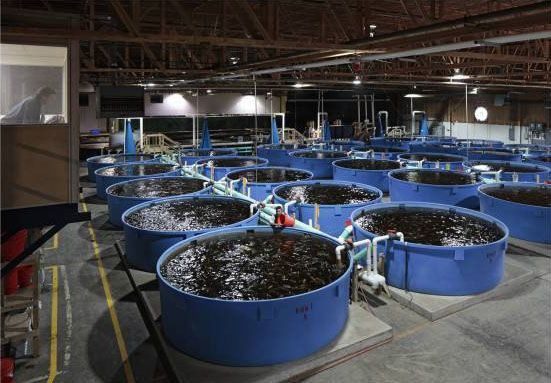
1. What is fish production and management?
Fish production and management refer to the practices involved in breeding, rearing, and harvesting fish in a controlled environment to maximize yield and ensure sustainability. This involves the selection of suitable species, proper feeding, disease control, and maintaining optimal water quality to support healthy fish growth.
2. Why is water quality important in fish production and management?
Water quality is crucial because it directly impacts the health, growth, and survival of fish. Poor water quality can lead to stress, disease, and high mortality rates. Key parameters such as temperature, pH, dissolved oxygen, ammonia, nitrites, and nitrates must be carefully monitored and managed to provide a conducive environment for fish.
3. What are the common types of fish farming systems?
- Pond Systems: Natural or artificial ponds are used to rear fish. These are common for species like catfish and tilapia.
- Recirculating Aquaculture Systems (RAS): These are closed-loop systems where water is filtered and recycled, allowing for high-density fish farming.
- Cage Systems: Fish are reared in cages placed in natural water bodies like lakes and rivers.
- Flow-through Systems: Water flows through tanks or raceways where fish are kept, providing a continuous supply of fresh water.
4. What species of fish are commonly farmed?
Commonly farmed fish species include tilapia, catfish, trout, salmon, carp, and barramundi. The choice of species depends on factors like market demand, environmental conditions, and the farmer’s expertise.
5. How do you select the right location for fish farming?
Selecting the right location involves considering factors such as water availability and quality, climate, topography, soil type, and proximity to markets. It’s essential to ensure that the site has a reliable water source and suitable conditions for the chosen fish species.
6. What are the feeding practices in fish production and management?
Feeding practices vary depending on the species and stage of growth. High-quality, nutritionally balanced feed is essential. Fish should be fed in appropriate quantities to avoid overfeeding, which can lead to water pollution. Feeding schedules and methods, such as hand-feeding or automatic feeders, should be designed to ensure efficient feed utilization.
7. How do you manage fish health and prevent diseases?
- Biosecurity: Implement measures to prevent the introduction and spread of pathogens, such as quarantine protocols and sanitation practices.
- Regular Monitoring: Frequently check fish for signs of disease or stress and monitor water quality parameters.
- Vaccination and Treatment: Use vaccines and treatments as necessary to prevent and control diseases.
- Healthy Stocking: Purchase disease-free fingerlings from reputable suppliers and avoid overstocking.
8. What is the role of genetics in fish production and management?
Genetics play a significant role in fish production and management by influencing growth rates, disease resistance, and overall productivity. Selective breeding programs aim to enhance desirable traits in fish stocks, leading to improved yields and sustainability.
9. How do you maintain optimal water quality in fish farming?
Maintaining optimal water quality involves regular monitoring and management of key parameters:
- Temperature: Keep water temperature within the optimal range for the species being farmed.
- pH: Maintain pH levels that are suitable for the fish species.
- Dissolved Oxygen: Ensure adequate aeration to maintain high oxygen levels.
- Ammonia, Nitrites, and Nitrates: Manage waste products through filtration systems and regular water changes.
10. What is the importance of sustainable practices in fish production and management?
Sustainable practices are crucial for ensuring the long-term viability of fish farming operations. This includes conserving water resources, minimizing environmental impact, reducing reliance on wild fish stocks, and promoting fish health and welfare. Sustainable practices help meet the growing demand for seafood while protecting natural ecosystems.
11. How can technology improve fish production and management?
Technology plays a vital role in enhancing efficiency and productivity in fish farming:
- Automated Feeding Systems: Improve feed efficiency and reduce labor costs.
- Water Quality Monitoring Systems: Provide real-time data for better management decisions.
- Recirculating Aquaculture Systems (RAS): Allow for intensive farming with minimal water usage.
- Genetic Improvement Programs: Enhance desirable traits in fish stocks through selective breeding and genetic engineering.
12. What are the economic considerations in fish farming?
Economic considerations include initial setup costs, operational expenses, and potential revenue. Factors such as the cost of land, infrastructure, feed, labor, and market prices for fish products must be carefully evaluated. A thorough business plan and financial analysis are essential for ensuring the profitability of fish farming operations.
13. What are the environmental impacts of fish farming, and how can they be mitigated?
Fish farming can have environmental impacts such as water pollution, habitat destruction, and the spread of diseases to wild fish populations. Mitigation strategies include:
- Sustainable Site Selection: Choose locations that minimize environmental disruption.
- Waste Management: Implement effective waste treatment and disposal systems.
- Eco-friendly Practices: Use sustainable feed sources and reduce the use of chemicals and antibiotics.
- Monitoring and Regulation: Adhere to environmental regulations and standards to minimize impacts.
14. How does climate change affect fish production and management?
Climate change can impact fish farming through changes in water temperature, availability, and quality. It can also affect the prevalence of diseases and the distribution of suitable habitats for different species. Adapting to climate change involves implementing resilient farming practices, such as using climate-tolerant fish strains and improving water management strategies.
15. What are the future trends in fish production and management?
Future trends in fish production and management include the adoption of advanced technologies such as precision aquaculture, which uses sensors and data analytics to optimize farming practices.
There is also a growing focus on sustainability, with an emphasis on reducing environmental impacts and enhancing the welfare of farmed fish. Innovations in feed production, such as the use of alternative protein sources, are expected to play a significant role in the future of fish farming.
In conclusion, understanding fish production and management involves a comprehensive approach to optimizing various aspects of aquaculture. By addressing water quality, feeding practices, disease prevention, and sustainability, fish farmers can achieve successful and profitable operations.
The integration of technology and adherence to best practices are essential for meeting the challenges and opportunities in the evolving field of fish farming.
Read Also: How to Make an Avocado Tree Bear Fruit

